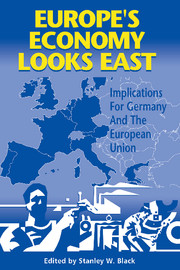Book contents
- Frontmatter
- Contents
- List of figures and tables
- Preface
- List of conference participants
- List of acronyms
- 1 Introduction
- I Trade relations
- 2 An economic assessment of the integration of Czechoslovakia, Hungary, and Poland into the European Union
- Comments
- 3 Potential trade with core and periphery: industry differences in trade patterns
- Comments
- 4 Impact on German trade of increased division of labor with Eastern Europe
- Comments
- II Investment patterns
- III Labor market issues
- IV The process of integration
- Index
3 - Potential trade with core and periphery: industry differences in trade patterns
Published online by Cambridge University Press: 03 February 2010
- Frontmatter
- Contents
- List of figures and tables
- Preface
- List of conference participants
- List of acronyms
- 1 Introduction
- I Trade relations
- 2 An economic assessment of the integration of Czechoslovakia, Hungary, and Poland into the European Union
- Comments
- 3 Potential trade with core and periphery: industry differences in trade patterns
- Comments
- 4 Impact on German trade of increased division of labor with Eastern Europe
- Comments
- II Investment patterns
- III Labor market issues
- IV The process of integration
- Index
Summary
Introduction
This paper analyzes the trade patterns that have evolved between a few Western European countries, on the one hand, and a group of formerly centrally planned economies in Europe, on the other hand, since the initiation of the transition process in these economies in the late 1980s. The analysis has two aims : first, to ascertain whether there have been significant differences, across Western countries, in the speed with which the potential macroeconomic benefits from the opening up of Eastern Europe have so far been realized ; and second, to assess whether there is any evidence to date to support the frequently voiced concern that east–west European economic integration might adversely affect output and employment in some “sensitive” sectors in Western Europe.
The group of transition economies considered in this study, denoted as CEEC-6, includes Bulgaria, the Czech Republic, Hungary, Poland, Romania, and the Slovak Republic. To keep the paper manageable, these countries have been grouped together, even though they differ from each other in some significant respects, including the extent to which they had historical ties with the Western countries in our sample and the precise time at which they began their transition to market-based systems. As for the sample of Western European countries, it includes the four largest economies of Europe (Germany, France, Italy, and the United Kingdom) and Portugal.
Germany is a natural choice given that it has had close historical ties with the transition economies and has quickly reestablished its position as a dominant trade partner for most of the CEEC-6 by virtue of its geographic location and economic size.
- Type
- Chapter
- Information
- Europe's Economy Looks EastImplications for Germany and the European Union, pp. 67 - 96Publisher: Cambridge University PressPrint publication year: 1997
- 2
- Cited by



